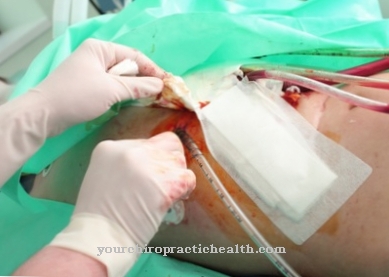Under the term Prenatal diagnostics various examinations that take place during pregnancy are summarized. They deal with the early detection of diseases and undesirable developments in the unborn child.
What is prenatal diagnosis?

As prenatal diagnosis (PND) are medical examination procedures and devices that deal with the early detection of diseases and malformations in the unborn child. Therapeutic countermeasures can be taken at an early stage through prenatal diagnostics. This can also be a surgical procedure or even the termination of pregnancy, which depends on the extent of the malformation or disease.
The term prenatal translated from Latin means “before birth”. Prenatal examinations are only used before birth and especially in the last two trimesters of pregnancy. The prenatal diagnosis can usually be carried out from the end of the third month of pregnancy.
Treatments & therapies
The prenatal diagnosis serves to exclude or reliably determine undesirable developments in the unborn child. These are primarily malformations that have a genetic background and often mean severe disabilities for the affected child. The results of prenatal diagnostics make it possible to determine certain genetic deviations such as rare hereditary diseases or diseases of the metabolism, blood and muscles.
These include a. Trisomy 21 (Down syndrome), Huntington's disease, Duchenne muscular dystrophy and cystic fibrosis. However, successful treatment of most diseases during pregnancy or after the birth of the child is only possible in rare cases. In addition, the prenatal tests cannot indicate the exact severity of the disability. Furthermore, only about five percent of all disabilities are inherited. Most of them arise later in life due to illnesses.
However, certain factors can make performing prenatal diagnostics with a specialist seem sensible. These are diseases of the mother, to which u. a. Epilepsy includes infections during pregnancy, genetic disorders within the family, and the occurrence of malformations in a previous pregnancy.Other possible reasons are conspicuous or unclear ultrasound findings during a gynecological examination, an already established malformation, the desire for an amniotic fluid puncture, or the presence of a multiple pregnancy.
With its examination methods, prenatal diagnosis complements the conventional procedures that routinely take place during pregnancy. The costs of prenatal procedures are usually only covered by the health insurance companies for special occasions such as the existence of certain hereditary diseases.
In some cases, performing prenatal diagnostics can cause severe stress for the parents. This raises important questions about further examinations and possible risks as well as the effects on future life if the child is disabled. The termination of pregnancy can also be discussed. These questions often cause psychological problems in parents. For this reason, prenatal diagnostics should be carefully considered in advance and discussed in detail with the doctor.
Diagnosis & examination methods
In prenatal diagnosis, it is important to distinguish between non-invasive and invasive examination methods. The term non-invasive means that the examination instruments do not penetrate the pregnant woman's organism. There are no risks for either the mother or the unborn child. Invasive procedures, on the other hand, penetrate the pregnant woman's body, which sometimes leads to certain dangers.
One of the most frequently performed non-invasive prenatal procedures is the ultrasound examination (sonography). Ultrasound examinations generally take place two to four times during pregnancy. Special sonographies such as neck fold measurements can also be performed. The ultrasound examination is just as risk-free as special blood tests. These include a. measuring blood pressure, CTG monitoring and determining iron levels. These measures are standard procedures.
If an invasive examination method is used, this means an intervention in the body of the mother and child. One of the most common invasive procedures is the amniocentesis (amniocentesis). The amniotic fluid is removed through the abdominal wall of the pregnant woman under ultrasound observation. Within the amniotic fluid there are cells of the child that provide information about possible disorders. The doctors pay attention to a deviation from the usual number of chromosomes.
Another invasive procedure is the chorionic villus sampling, in which placenta is removed. This investigation is u. a. made to rule out Down syndrome. The same goes for umbilical cord puncture. In this method, the gynecologist takes umbilical cord blood from the child to examine the blood cells it contains. Anesthesia is not necessary for either examination method, which can be compared to taking a blood sample. The diagnosis is always carried out on an outpatient basis. Preimplantation diagnostics is a special case within prenatal examination methods.
Examinations are carried out on embryos that are a few days old and were created in the context of artificial insemination. The examination takes place before the embryo is transferred into the uterus. With this method, possible changes in the chromosomes can be determined in good time. This includes, for example, a change in the number of chromosomes. Changes in individual genes can also be determined.
Although the invasive methods of prenatal diagnosis provide valuable information, they also harbor some dangers. This can lead to a miscarriage. However, the risk is considered to be relatively low.

























.jpg)


